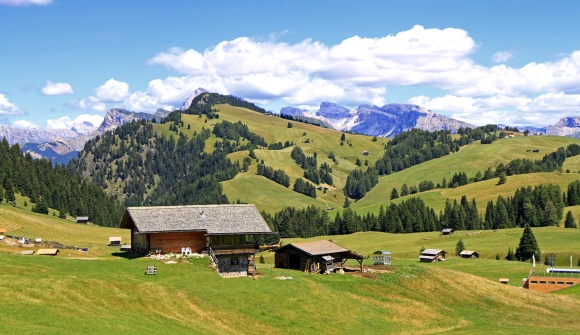
Sciliar-Catinaccio Natural Park
This post is also available in:
 Italiano (Italian)
Italiano (Italian)
The Sciliar-Catinaccio Natural Park, in the western Dolomites Mountain Range of South Tyrol, is a 17.300-acre natural area – together with Alpe di Siusi landscape protection site, is the largest mountain pasture in Europe.
Established in 1974, it is very famous mainly thanks to the Sciliar Massif (nicknamed the “Mount of Destiny” by the locals), and two of its peaks: “Punta Santner” and “Punta Euringer” – true icons of South Tyrol.
The park area, which also includes the Catinaccio Massif, stretches among the municipalities of Castelrotto, Fié allo Sciliar, and Tires al Catinaccio.
Inside the park, there’s a great variety of extremely rich flora and fauna, thanks to a most ideal natural environment,
The entrance to the “Steger Säge” Information Centre is in Bagni di Lavina Bianca, in the municipality of Tires. Set up inside an old water mill, which powers a hydraulic sawmill, it offers a wealth of information about the geomorphological and natural features of the Dolomites (the peculiar shape of the Sciliar Massif can be actually traced back to its unusual geological composition).
The Park is part of “Natura 2000” European ecological network, aimed at protecting natural and semi-natural habitats, their flora and fauna.
FLORA AND FAUNA
The Sciliar-Catinaccio Nature Park features mixed conifer woods that literally surround the Sciliar Massif. On the other hand, he woods on Castelvecchio Massif are mainly made of Norway spruce (Picea abies), while the slopes of Monte Cavone (5.718 ft) are covered with a forest of Norway spruces, Scots pines (Pinus sylvestris), and larches (Larix decidua).
The lake of Fiè inside the park is surrounded by a wooded strip of Scots pine (Pinus sylvestris) and it’s a very popular destination especially during the summer months.
The herbaceous flora includes crocuses, rhododendrons, bear’s ears (Primula auricula), Einsel’s columbines (Aquilegia einseleana), and Moretti’s bellflowers (Campanula morettiana). In the ponds and along the streams, there are abundant Primula farinosa, Pinguicula alpina, many species of mosses and of eriophora genus.
Many different habitats can be found on the very Sciliar Massif, mostly above the tree line.
They feature “endemics” plant species, as well as flowers of rock, grassland and scree areas.
Other typical plants found here and in the Alps are Moretti’s bluebells (Campanula morettiana).
The fauna includes many beetles and butterflies, common crossbills (Loxia curvirostra), the alpine choughs, willow tits, spotted nutcrackers, the rock ptarmigans, red-billed choughs, Eurasian dotterels, golden eagles and common ravens. Groups of chamois are frequently observed.
This post is also available in:
 Italiano (Italian)
Italiano (Italian)
Contatti
Tires(BZ)
0471 642196
info.sc@provincia.bz.it




